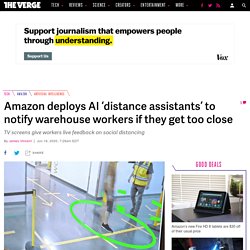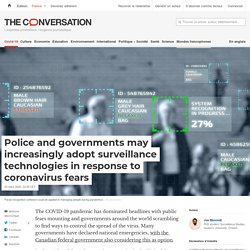

Amazon’s AI-powered ‘distance assistants’ will warn workers when they get too close. Amazon, which is currently being sued for allegedly failing to protect workers from COVID-19, has unveiled a new AI tool it says will help employees follow social distancing rules.

The company’s “Distance Assistant” combines a TV screen, depth sensors, and AI-enabled camera to track employees’ movements and give them feedback in real time. When workers come closer than six feet to one another, circles around their feet flash red on the TV, indicating to employees that they should move to a safe distance apart. The devices are self-contained, meaning they can be deployed quickly where needed and moved about.
Why some people can't resist crowds despite the pandemic. The Conference Board of Canada. Millions have been relying on the Canada Emergency Response Benefit (CERB) these past few months.

This has been an extraordinary response to an extraordinary time. But people concerned about fighting poverty are looking to draw lessons from the pandemic for the future. Discussion is growing around the creation of a universal basic income for Canadians. This episode, the Honourable Hugh Segal, Canadian political strategist, author, commentator, academic, and former senator, joins us to talk about a guaranteed basic income for Canadians. 'Zoom-bombing' attacks on video conferencing platform leave victims shaken. 'Zoom fatigue' is setting in: What it is and how to prevent it. Judy Lee, a content writer in Mississauga, Ont., started feeling sluggish lately in a way she hadn't before, back when she could still meet clients in person.

"I was feeling really exhausted, but I didn't know why," she said. Working from home in Ottawa, entrepreneur Stefan Kollenberg was experiencing something similar. By the end of the day, he said his eyes felt sore and dry, and that he was "emotionally drained. " Both Lee and Kollenberg would later put a name to what they were experiencing — a type of mental exertion that's become known as "Zoom fatigue," named after the popular video chat software.
Although the term may not be found in psychology textbooks, some psychologists say the condition has become all too common in the COVID-19 era, with so many people working from home and holding meetings through video conferencing applications such as Skype, Microsoft Teams, Google Meet or Cisco Webex. "It's not just my work calls … it's also the casual 'Hello.'
'Zoom fatigue' is setting in: What it is and how to prevent it. Homebound Canadians are on the hunt for stuff to keep them from getting bored and out of shape. Kijiji data shows a surge in demand for video game consoles and fitness equipment from Canadians stuck at home We all know that toilet paper has improbably emerged as the most sought-after consumer item amid the COVID-19 shutdown, but as Canadians hunker down they’re also scouring the web for things to keep them entertained — and in shape.

Maclean’s asked Kijiji to share data on trends emerging from people using its site, an online classified service. According to the company Canadians have ramped up their interest in home entertainment and fitness items over the past week. Here are the consumer electronics items that have seen the biggest increase since March 18 compared to the the average of the three-week period from Feb 16 to March 7.
Computers: five per centTVs and video: 12 per centComputer accessories: 38 per centVideo games and consoles: 79 per cent. Sex and social distancing: How the coronavirus crisis is changing intimacy. Police and governments may increasingly adopt surveillance technologies in response to coronavirus fears. The COVID-19 pandemic has dominated headlines with public fears mounting and governments around the world scrambling to find ways to control the spread of the virus.

Many governments have declared national emergencies, with the Canadian federal government also considering this as option. In the midst of these fears, tech companies in the United States have reportedly been in talks with the U.S. government and other agencies to use their data gathering and data location tools to track virus transmission trends. This includes the controversial facial-recognition startup, Clearview AI. Policing applications. Coronavirus outbreak: doctors use robot to treat first known US patient. Doctors have been using a robot to treat the first person known to have been admitted to hospital in the US with a new strain of the coronavirus, as part of an effort to prevent the spread of the disease, which has killed at least 17 people in China and infected hundreds more.

The man in his 30s was admitted to the special pathogens unit in a hospital in Everett, Washington, on Monday. The US citizen had recently returned from a trip to central China and had been diagnosed in Seattle. Dr George Diaz, the section chief of infectious diseases at Providence Regional Medical Center Everett, told the Guardian the patient was in a “satisfactory condition” on Wednesday. He did not give an update on how long the patient would remain in the unit. Diaz said he had sat outside a window of the patient’s 20ft x 20ft room to operate the robot, which was equipped with a camera, microphone and stethoscope. Robots rising: Coronavirus drives up demand for non-human labour in China. SHANGHAI: A shortage of workers and restrictions on human contact because of the coronavirus pandemic is driving up demand for service robots in China, potentially boosting a sector that has struggled to scale up commercially.

Venture capitalists with expertise in the robotics sector said they are anticipating orders from China to rise significantly this year, based on interest since the end of January when the virus began spreading in China. That could take the use of service robots from novelties that deliver food and drink in restaurants and hotels to an army that performs essential functions in hospitals bound by strict no-contact rules. "The healthcare segment has been really hot," said Emil Jensen, vice president of China sales for Denmark-based Mobile Industrial Robots, which makes customisable robots that are used both in hospitals and on factory floors. Among those in demand are disinfectant robots, which cast UV lights across a room to kill germs.
Hooman Samani. Coronavirus: Sex robot company tells people dolls are clean - New York Daily News. Despite setbacks, coronavirus could hasten the adoption of autonomous vehicles and delivery robots. This week, nearly every major company developing autonomous vehicles in the U.S. halted testing in an effort to stem the spread of COVID-19, which has sickened more than 250,000 people and killed over 10,000 around the world.

Still some experts argue pandemics like COVID-19 should hasten the adoption of driverless vehicles for passenger pickup, transportation of goods, and more. Autonomous vehicles still require disinfection — which companies like Alphabet’s Waymo and KiwiBot are conducting manually with sanitation teams — but in some cases, self-driving cars and delivery robots might minimize the risk of spreading disease. Rise of robots hastened by coronavirus Coronavirus Pandemic: A Call to Action for the Robotics Community. When I reached Professor Guang-Zhong Yang on the phone last week, he was cooped up in a hotel room in Shanghai, where he had self-isolated after returning from a trip abroad.

I wanted to hear from Yang, a widely respected figure in the robotics community, about the role that robots are playing in fighting the coronavirus pandemic. He’d been monitoring the situation from his room over the previous week, and during that time his only visitors were a hotel employee, who took his temperature twice a day, and a small wheeled robot, which delivered his meals autonomously. An IEEE Fellow and founding editor of the journal Science Robotics, Yang is the former director and co-founder of the Hamlyn Centre for Robotic Surgery at Imperial College London.
More recently, he became the founding dean of the Institute of Medical Robotics at Shanghai Jiao Tong University, often called the MIT of China. ‘Forza’ for Malaysia: Harnessing social capital to combat Covid-19. COMMENT | With daily reports showing the serious spread of Covid-19, it is necessary to expand the discussion of potential solutions to the crisis.

Pandemics and social capital. The global spread of COVID-19 threatens to have serious economic consequences worldwide. This induces us to look at the past for some hints about the possible long-term effects of a severe pandemic. The case of the Spanish flu that started in spring 1918 and spread rapidly across the world seems to be a particularly useful term of comparison. Instagram Provides Tips on Maintaining Connection via Instagram Live During COVID-19 Lockdowns. The current COVID-19 lockdowns are hard on everyone, but the reality is that we'll probably be dealing with social limitations, at least in some capacity, for some time yet.
The prolonged isolation will require us to adapt our social practices, and find new ways to stay connected - and for brands and marketers looking to keep their businesses running amid the ongoing crisis, that also means considering new ways to engage our audiences, and provide assistance where possible for the many people in need. One option to consider is live-streaming - while no social video option can replace IRL connection, the immediate, interactive capacity of live video is likely the closest we have to holding a face-to-face discussion.
And Instagram Live can be a great option on this front. You may not feel comfortable going live, it may not be something that interests you. But it could definitely be worth some extra thought. Screen Time and Young People in the Age of Social Distancing. Last week, I received an email from the superintendent of my daughter’s school district. In response to the COVID-19 pandemic and efforts to curb the spread of the virus, schools in her district would close a week early for spring break. Less than a week later, the governor of Oregon, Kate Brown, announced that schools would remain closed until the end of April, at least. article continues after advertisement. America Faces a Social Recession. Chronic loneliness has many causes—greater geographic mobility; the often isolating effects of technology; a culture that defines success as the pursuit of power, wealth, and fame.
When children are asked what their parents want most for them, they say their parents value achievement over being kind to others. But the less we prioritize connections with other people and the more we allow the quality of our interactions to decline, the more our social muscle begins to atrophy. Just like any other muscle, it weakens out of disuse. This can make high-quality social connection even harder. That’s why the potential effects of physical distance from other people are so worrisome. 'Pandemic pen pals' helping cut through social isolation. Thai hospitals deploy 'ninja robots' to aid virus battle - Science & Tech. Thai hospitals are deploying "ninja robots" to measure fevers and protect the health of overburdened medical workers on the frontlines of the coronavirus outbreak.
First built to monitor recovering stroke patients, the machines have been quickly repurposed to help fight the disease, which has so far killed nearly 9,000 people around the world. They have helped staff at four hospitals in and around Bangkok to reduce their risk of infection by allowing doctors and nurses to speak to patients over a video link. "They can stand outside the room and communicate with patients inside through the robot," said Viboon Sangveraphunsiri of Chulalongkorn University. Later models will be designed to bring food and medicine to patients, and could also eventually be used to disinfect hospital wards, Viboon told AFP. His engineering team is racing to build more "ninjas" -- known as such because of their matte black exterior -- for another 10 hospitals around the country. close x close x. Tech tips and tricks to cope with coronavirus social isolation measures. Digital Solutions To Make Sure Social Distancing Doesn’t Lead To Social Isolation During Coronavirus Outbreak.
As we practice social distancing during COVID-19, it’s vital that we engage in creative activities that bring us together virtually. What’s important to understand is this: as we place physical distance between others and remain isolated in our apartments and homes, we must maintain emotional connections with others in our lives.